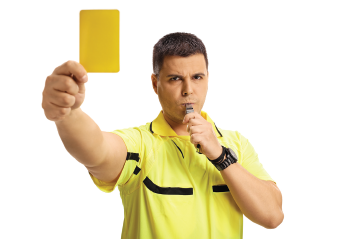Medical Passports, in Yellow
If you are a soccer fan, you know a yellow card is used by the referee to discipline players for misconduct or failing to follow the rules. A player who is given a yellow card may continue to play, but he is being placed on notice: if he receives a second yellow card, the player is dismissed from the field.5
If you are a world traveler, you know that a Yellow Card or Carte Jaune is the sobriquet for an International Certificate of Vaccination or Prophylaxis (ICVP). On May 25, 1951, the World Health Organization (WHO) adopted the International Sanitary Regulations that created an internationally recognized certificate that could be used to document receipt of a vaccine recognized by the WHO, such as the vaccines against cholera and smallpox.6 The Yellow Card nickname was inevitable, because the certificates were issued on yellow pieces of paper; the fact that these certificates were often used, specifically, to document yellow fever vaccination sealed the deal.

Ljupco Smokovski / shutterstock.com
The Yellow Card holds the expected demographic information, either in English or French, followed by a list of vaccinations; a stamp from the administering center makes it official. Because it is internationally recognized, it essentially serves as a medical passport for the traveler who aspires to visit a country where specific preventable diseases are endemic.
It’s easy to see why interest in Yellow Cards has increased of late: They provide an easy answer to an awkward question. It is heartening to know the U.S. is vaccinating more than 3 million people in a single day.7 With three coronavirus vaccines already having received emergency use authorization by the U.S. Food & Drug Administration (FDA), that record may be broken serially. The problem is that, even with vaccinations proceeding at breakneck speed, there will still be a prolonged period when the world is divided between the have-been-vaccinated and the have-nots.
Until everyone is immune, what do we do? Should everyone continue to politely mask and distance and avoid all human contact until we reach the vaccination finish line?
The U.S. Centers for Disease Control & Prevention (CDC) has said aloud what all of us were thinking: On March 9, it updated its guidance to state that if you have been fully vaccinated:8
- You can gather indoors with fully vaccinated people without wearing a mask;
- You can gather indoors with unvaccinated people from one household without masks; and
- If you have been in contact with someone who has COVID-19, you do not need to isolate.
Nationwide, you could almost hear thousands of car doors simultaneously slamming, as grandparents across the country jumped into their vehicles to see their grandchildren.
At the same time, thousands more have been parsing the CDC recommendations as if they were a plot point in The Da Vinci Code. If the fully vaccinated can gather maskless, why shouldn’t they be able to gather in a Boeing 737 or on a beach or on a cruise ship? Do we really need to wait for the whole world to be vaccinated before we can get on with our lives?
Enter the Yellow Card.



